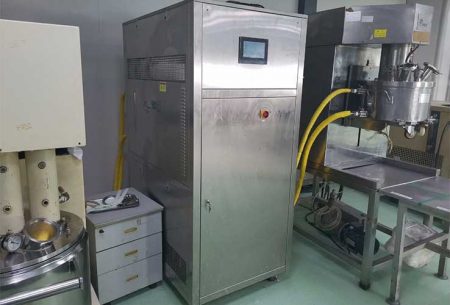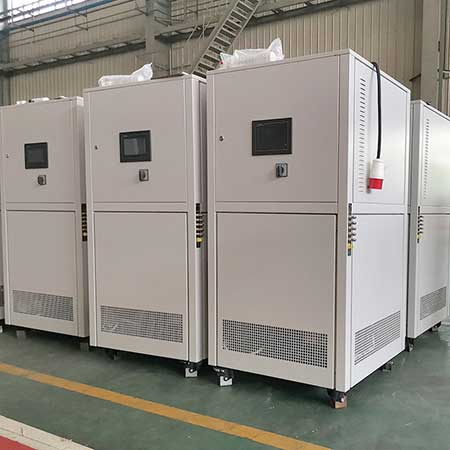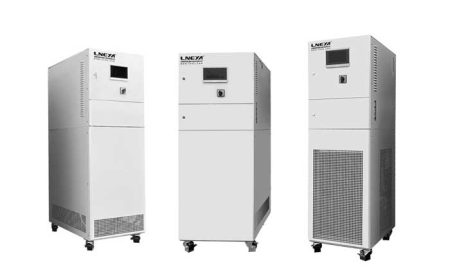Process Chilled Water Systems
Contactez-nous dès aujourd'hui pour une solution parfaite de contrôle de la température
Process Chilled Water Systems are indirect cooling devices used for key equipment in semiconductor, microelectronics and other industries. Divided into open system and closed system.
Process Chilled Water Systems have a wide range of applications, involving all aspects of industrial production, including semiconductors, microelectronics, industrial refrigeration machines, steam turbine exhaust condensation in thermal power plants, large central air conditioners, coal chemical industry, petrochemical plants, and natural gas pipeline cooling A large amount of process cooling water is used in such places. In many product or process production environments, clean workshops are required. The temperature and relative humidity in the workshop are required to be maintained within a certain range throughout the year. Some of the production processes generate large amounts of heat, and process equipment requires low-temperature water cooling. Even in winter, air conditioning is still required for cooling. , in order to meet these requirements, Process Chilled Water Systems must be built.

The composition and working principle of Process Chilled Water Systems
Process Chilled Water Systems mainly include the following parts: chillers, pumps, heat exchangers, water tanks, filters, and process equipment.
Chiller: Provides cold source for cooling water system.
Water pump: pressurizes water to ensure its circulation in the cooling system.
Heat exchanger: This equipment is used to exchange heat between the chilled water system and the cooling water system to transfer the heat generated at the load end of the system to the chilled water system. There are many types of heat exchangers, which can be divided into shell-and-tube type, plate type, plate-fin type, heat pipe type, etc. In comparison, plate heat exchangers have the advantages of small floor space and large heat transfer area. Considering the space and cost characteristics of semiconductor factories, equipment with small floor space is preferred to save land area and project cost.
Water tank: The water tank in the open system mainly serves to supplement the water source. The water tank in a closed system needs to choose an expansion water tank. The expansion water tank has three functions. One is to contain and compensate for the expansion and contraction of water in the system; the other is to provide stable pressure to the closed circulating water system and stabilize the system pressure; The third is as an instruction for the system water replenishment pump, usually the expansion tank sends a signal to start or shut down the system water replenishment pump.
Filter: Filter out solid impurities in the water and purify the water source.
Process Chilled Water Systems has two relatively independent systems: chilled water and cooling water. Chilled water is provided by a chiller. Chilled water exchanges heat with cooling water to cool the cooling water and thereby reduce the temperature of the equipment. Water is pumped from the production equipment through the water pump to the heat exchanger to ensure the temperature of the process cooling water by controlling the amount of chilled water. After passing through the filter, it is sent to the production line equipment and then returns to the water pump. The process cooling water is circulated repeatedly. Chilled water is returned directly to the chiller.

Process Chilled Water Systems Mode Selection
The mode of process cooling water system is divided into open system and closed system. How to choose open system and closed system during the design process should be based on the following situations:
① When the height difference between the highest point of the process equipment and the water pump plate replacement equipment is relatively large (height difference exceeds 10m), it is recommended to use a closed system, so that the residual pressure and static head of the equipment can be fully utilized;
② When the water supply pressure of process equipment is very high but the pressure difference of the equipment is not large, it is recommended to use a closed system, so that the residual pressure of the pipe network can be used to reduce the water pump head and save energy;
③When the plant process equipment is put into production in phases or in batches or when the equipment update and adjustment are relatively simple, considering the system debugging ability, it is recommended to use an open system, which can speed up the system debugging and operation. At the same time, due to the addition of a water tank, the system retains more water and the cold source When interrupted, it has certain accident buffering capabilities.
④ From the perspective of energy saving, the use of a closed system can greatly reduce the head of the process cooling water supply circulation pump. On the one hand, it can save the initial investment, on the other hand, it can save energy and reduce operating costs.
⑤ When the cooling water temperature of the equipment can be directly cooled by a cooling tower on the hottest days or the owner requires low investment, an open system can be used. When the equipment cooling water inlet temperature cannot be met by an open cooling tower, a closed system is used, using chilled water as the refrigerant.
Nous assurons la conception et la fabrication de systèmes complets de contrôle de la température. Des modèles standard aux produits personnalisés complets jusqu'à 900 tonnes. Nous sommes spécialisés dans le service à la clientèle et nous nous efforçons d'aider chaque client à obtenir le système de contrôle de la température optimal pour ses besoins spécifiques.
Nous fournissons des solutions personnalisées non standard. Nous proposons aussi bien des refroidisseurs à simple refroidissement que des unités combinées de refroidissement et de chauffage.
Courriel : info@lneya.com ID WeChat : +8615251628237 WhatsApp : +86 17851209193

Refroidisseurs à circulation / Circulateurs frigorifiques
Le refroidisseur peut être largement utilisé dans diverses industries et laboratoires, et peut être conçu sur mesure.
| Plage de température | Série -25°C ~ +30°C | Série -45°C ~ +30°C | Série -60°C ~ -20°C | Série -80°C ~ -20°C | Série -120°C ~ -70°C | ||||
| Capacité de refroidissement | 0,8 ~ 30kW | 0,75 ~ 12kW | 0,4 ~ 6kW | 0,2 ~ 6kW | 0,3 ~ 5kW | ||||
| Note : Toute plage de température de -150℃ ~ +350℃ et toute capacité de refroidissement peuvent être personnalisées. | |||||||||
 Refroidisseurs d'eau / Petits refroidisseurs
Refroidisseurs d'eau / Petits refroidisseurs
Le refroidisseur peut être largement utilisé dans diverses industries et laboratoires, et peut être conçu sur mesure.
| Plage de température | -18°C ~ +30°C | Série +5°C ~ +35°C | |||||||
| Capacité de refroidissement | 0,35 ~ 0,9kW | 1,8 ~ 50kW | |||||||
| Note : Toute plage de température de -150℃ ~ +350℃ et toute capacité de refroidissement peuvent être personnalisées. | |||||||||

Refroidisseurs à basse température
Nous sommes spécialisés dans la production de refroidisseurs à basse température avec une plage de contrôle de la température allant jusqu'à -150°C, qui peuvent répondre aux besoins de réfrigération de différentes industries.
| Plage de température | Série -25°C ~ -5°C | Série -45°C ~ -10°C | Série -60°C ~ -10°C | Série -80°C ~ -30°C | Série -110°C ~ -50°C | Série -150°C ~ -110°C | |||
| Capacité de refroidissement | 12 ~ 360kW | 6 ~ 180kW | 6 ~ 180kW | 4 ~ 180kW | 2 ~ 120kW | 2,5 ~ 11kW | |||
| Note : Toute plage de température de -150℃ ~ +350℃ et toute capacité de refroidissement peuvent être personnalisées. | |||||||||

Refroidisseurs à haute température
Le refroidisseur peut être largement utilisé dans diverses industries et laboratoires, et peut être conçu sur mesure.
| Plage de température | +5°C ~ +40°C | -25°C ~ +40°C | -45°C ~ +40°C | -80°C ~ +80°C | -100°C ~ +80°C | ||||
| Capacité de refroidissement | 6 ~ 40kW | 2 ~ 15kW | 1 ~ 8kW | 0,6 ~ 3kW | 1,5 ~ 3kW | ||||
| Note : Toute plage de température de -150℃ ~ +350℃ et toute capacité de refroidissement peuvent être personnalisées. | |||||||||
Refroidissement et chauffage Chillers

Refroidissement et chauffage Chillers
Plage de contrôle de la température : -120°C à +350°C
thermostat de refroidissement et de chauffage, largement utilisé dans diverses industries.
| Plage de température | Série -10 ~ +150°C | Série -25 ~ +200°C | Série -25 ~ +300°C | Série -45 ~ +250°C | Série -45 ~ +300°C | Série -60 ~ +250°C | Série -60 ~ +300°C | Série -70 ~ +250°C | Série -80 ~ +250°C | Série -90 ~ +250°C | Série -100 ~ +100°C | ||
| Capacité de refroidissement | 1,5 ~ 15kW | 1 ~ 200kW | 1 ~ 200kW | 0,45 ~ 200kW | 0,9 ~ 25kW | 0,25 ~ 60kW | 0,75 ~ 25kW | 0,4 ~ 15kW | 0,3 ~ 80kW | 0,2 ~ 80kW | 0,45 ~ 80kW | ||
| Note : Toute plage de température de -150℃ ~ +350℃ et toute capacité de refroidissement peuvent être personnalisées. | |||||||||||||

Refroidisseurs à circulation
Plage de contrôle de la température : -45°C à +250°C
| Plage de température | Série -25°C ~ +200°C | Série -45°C ~ +250°C | |||||||
| Capacité de refroidissement | 1 ~ 15kW | 0,25 ~ 15kW | |||||||
| Note : Toute plage de température de -150℃ ~ +350℃ et toute capacité de refroidissement peuvent être personnalisées. | |||||||||
 LNEYA
LNEYA
 简体中文
简体中文


















































































